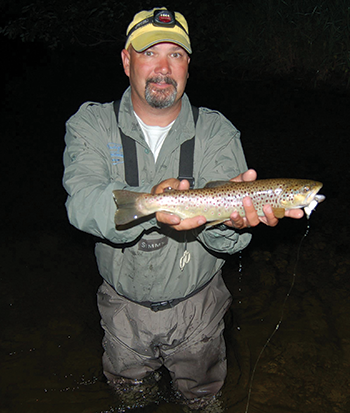
Fly fishing for trout is a dramatically visual sport. Watching a faux mayfly made of feathers and thread as it drifts downstream and disappears into a swirl on the surface is exactly what flips many an angler’s switch.
And, it doesn’t have to be a dry fly. Anglers who fish streamers — sinking flies that imitate baitfish — often talk about the fish they “moved” or “turned” or “rolled,” trout they saw attack their fly, even if they didn’t connect with them. A fair percentage of the accomplished fly fishermen I know even prefer streamer fishing to other methods, simply for the visuals.
It’s a different world on a trout stream at night. You can become mesmerized by the sounds; the gurgling of the water, the buzz of cicadas, the songs of the frogs and the calls of owls or whip-poor-wills echoing eerily over the nightscape.
“You get to watch an apex predator charge right through your fly,” trout guide Kyle Hartman commented to me one day when exactly that happened while we were streamer fishing on the Pere Marquette River. “It doesn’t get any better than that.”

Even nymph (aquatic insect larva) fishing is visual. Although nymphing typically involves dead drifting a small fly along the bottom, well out of sight, the take is often visual as the line jumps when a trout takes the bug.
I love it all. But if forced to choose a favorite, I’d bypass all those opportunities for the sensations that you experience when you can’t see a thing: trout fishing after dark.
It’s a different world on a trout stream at night. You can become mesmerized by the sounds; the gurgling of the water, the buzz of cicadas, the songs of the frogs and the calls of owls or whip-poor-wills echoing eerily over the nightscape. Ordinary events become extraordinary in the blackness of a trout stream on a warm summer night.
A moonless night, with a starry sky that would cause Van Gogh to second guess whether he got it right, may be a treasured event, but it’s one I would gladly forgo for enough cloud cover to turn the surroundings coal black. Darkness is the night angler’s friend. That’s when the giant brown trout, seemingly as long as your leg, come out to feed.
Admittedly, there is an element of danger associated with fishing after dark that heightens the experience. There are not many veteran night anglers who haven’t been baptized by a submerged limb grabbing them by the ankle as they wade in the shallows, though they’re more likely to suffer a heart attack from the beaver they didn’t realize was there tail-slapping the surface just feet away.
Night fishermen can make use of their entire repertoire, though the bulk of them fish dry flies. There are fly hatches after dark that tip off the presence of fish and you can hear them feeding on hatching or dying bugs. The Hex hatch (Hexagenia limbata, the giant Michigan mayfly) is an almost religious experience for trout fishermen, who know it is probably the best chance they’ll have to interact with a giant brown.

At night, anglers fish by sound; they listen for feeding fish, then try to slip into casting range to take a shot at them. Sometimes the fish sound like golf balls hitting the water, other times they sound like noisy kisses. Sometimes the biggest fish make the least noise.
Some anglers choose to ignore the hatches and fish with large splashy flies, using patterns that sometimes resemble, but are generally called mice. Unlike dry fly fishing, there’s no need for dainty presentations. They try to cover the water and when they hear what sounds like a cinder block hitting the water, set the hook.
Night fishing isn’t for everyone. If you’re timid or easily spooked, it may not be your game. But then again, maybe it is. You’ll never know if you don’t go. ≈
Bob Gwizdz is a career outdoor writer. He lives in East Lansing with his wife, son, and a crazy English setter.
*Photography by Bob Gwizdz







Facebook Comments